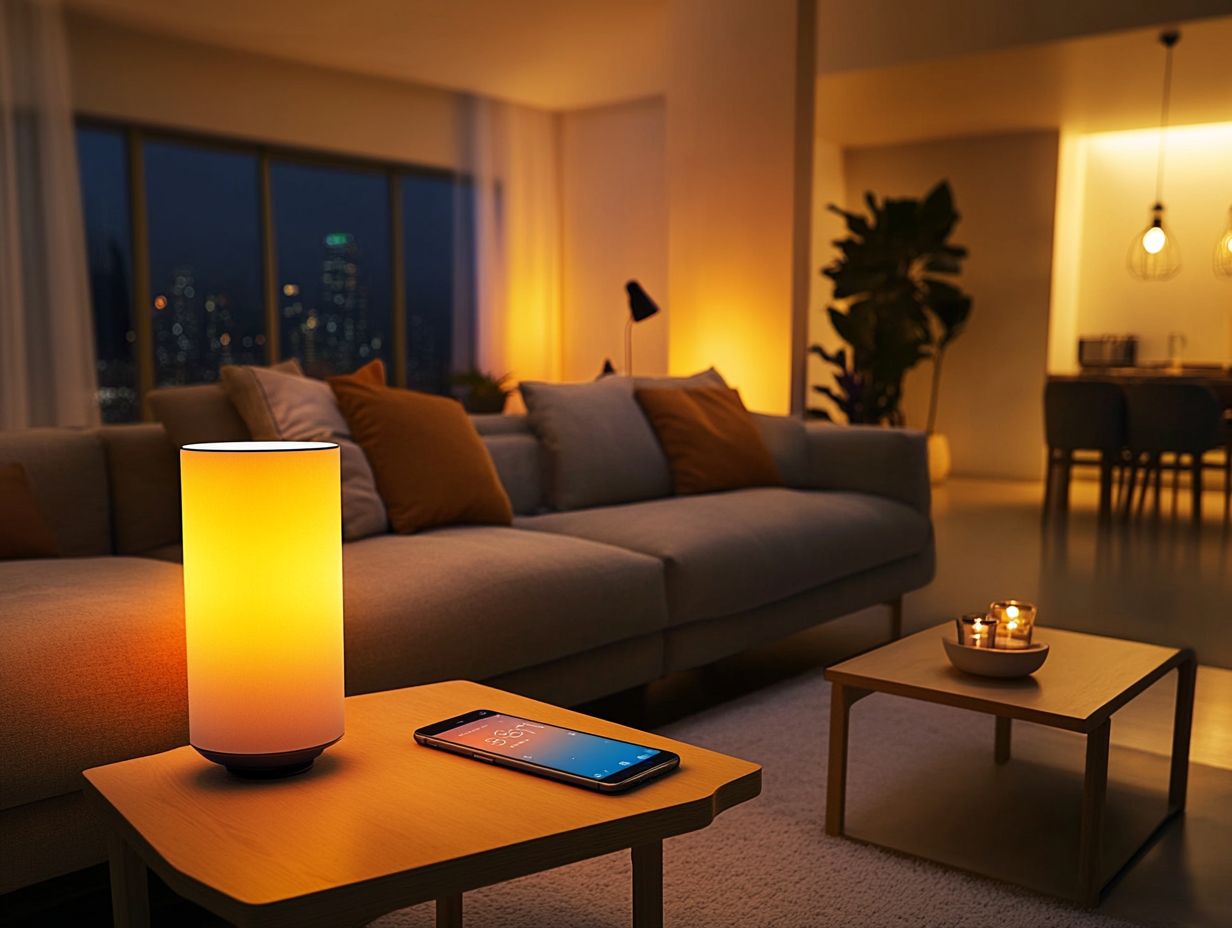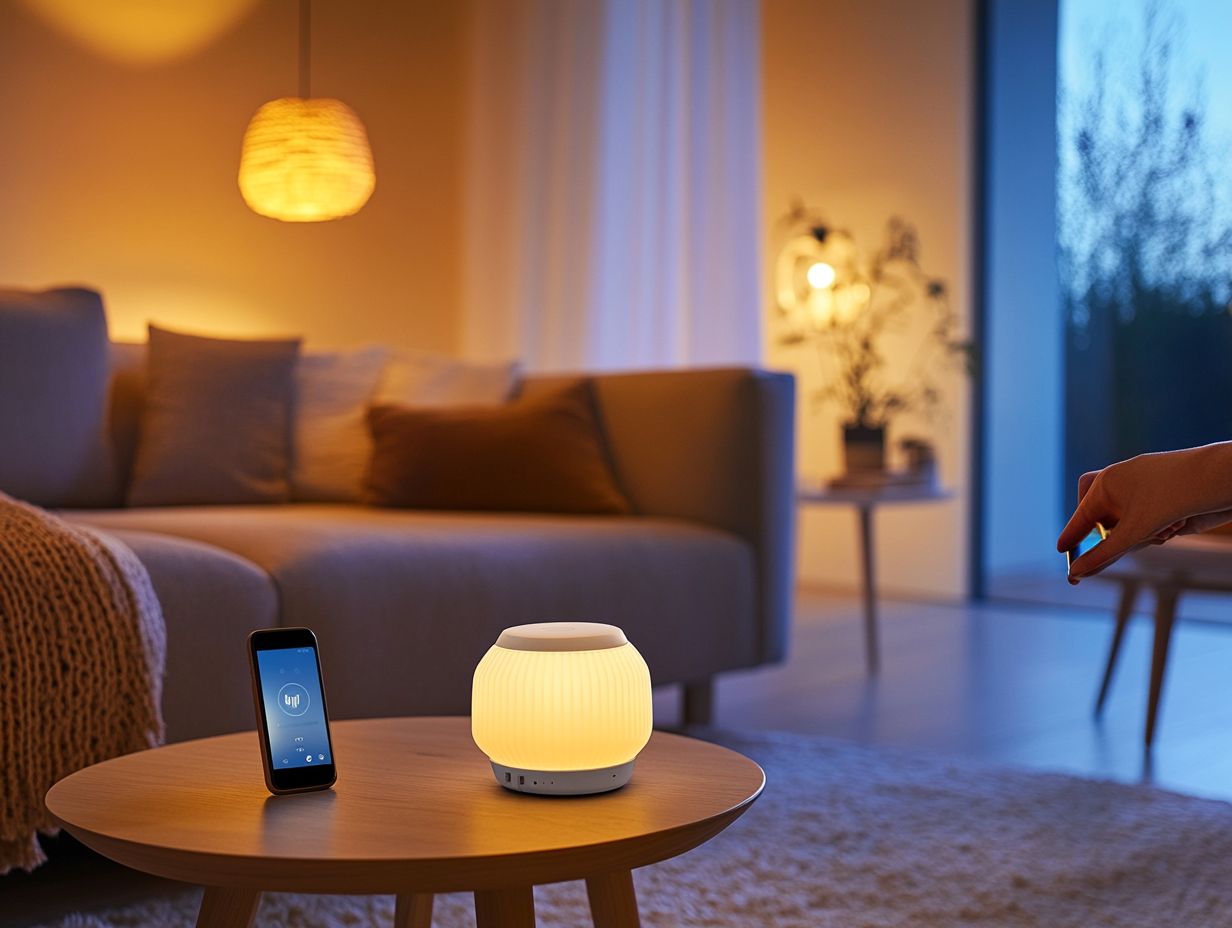“Choosing Wireless Lighting for Convenience”
Wireless lighting is changing how you light your spaces. It offers unmatched convenience and flexibility.
These systems enhance energy efficiency. They also create a neat space by removing tangled cords and complicated wiring.
This guide covers the benefits of wireless lighting. You’ll find key factors to help you select the right system for your needs.
It addresses common troubleshooting issues. You’ll also get maintenance tips to keep your system running smoothly.
Whether you want to upgrade your home or improve your workspace, this guide provides all the information you need.
Contents
- Key Takeaways:
- Benefits of Wireless Lighting
- Factors to Consider When Choosing Wireless Lighting
- Installing Wireless Lighting
- Troubleshooting Common Issues
- Frequently Asked Questions
- What is wireless lighting and why should I consider it for convenience?
- What are the different types of wireless lighting systems available?
- How can I choose the right wireless lighting system for my home?
- What are the benefits of using wireless lighting for convenience?
- Are there any downsides to using wireless lighting for convenience?
- Can I install wireless lighting on my own, or do I need professional help?
Key Takeaways:

- Wireless lighting offers convenience and flexibility, allowing for easy control and customization of lighting in any space.
- Wireless lighting helps reduce energy consumption and lower costs.
- When choosing wireless lighting, consider factors such as budget, compatibility, and the different types of systems available for seamless integration into your space.
What is Wireless Lighting?
Wireless lighting is a modern solution that lets you control lights without complicated wiring. This technology uses a wireless connection, making it a key player in the realm of smart lighting.
With just a user-friendly smartphone app, you can effortlessly adjust illumination levels, set timers, and create schedules tailored to your lifestyle.
By incorporating elements like smart bulbs, hubs, and sensors, this system offers remarkable flexibility, allowing for remote operation. The light fixtures communicate seamlessly through protocols such as Wi-Fi or Bluetooth, enabling interaction from virtually anywhere.
When integrated into automated lighting systems, you can fine-tune your environment, adjusting brightness and color temperature to match your mood or activities. This enhances your comfort and promotes energy savings, ensuring that your lights are only on when you truly need them.
Benefits of Wireless Lighting
Wireless lighting presents a wealth of benefits that elevate both convenience and energy efficiency in contemporary homes and commercial spaces. It has become a favored choice for those seeking smart lighting solutions.
Imagine controlling your lights with just a tap on your smartphone! Enjoy the thrill of saving energy while lighting up your life.
Convenience and Flexibility
One of the most compelling advantages of wireless lighting is the unparalleled convenience it offers you, allowing effortless control of your lighting fixtures through a smartphone app. This flexibility enables you to set timers, create schedules, and turn lights on or off remotely, significantly enhancing your living experience.
For instance, platforms like Google Home and Amazon Alexa seamlessly work together with various wireless lighting systems, letting you use voice commands for immediate adjustments. Imagine returning home after a long day at work to a house that brightens just for you, thanks to pre-set schedules activating your favorite lighting scenes.
You can even program your lights to mimic your presence while you’re away, adding an extra layer of security. This adaptability to your personal routines not only simplifies your everyday tasks but also contributes to energy savings, making wireless lighting a smart and sustainable choice for modern living.
Energy Efficiency
Energy efficiency plays a pivotal role in the rising appeal of wireless lighting systems. These systems often feature LED lights that consume significantly less power than traditional bulbs. By opting for these energy-efficient solutions, you not only enjoy lower monthly utility bills but also contribute to substantial energy savings in both residential and commercial spaces.
These systems often come with smart lighting features that elevate their functionality. For instance, smart lighting that adjusts automatically can seamlessly change brightness based on natural light conditions or occupancy. This smart method cuts down on wasted electricity, making your space more efficient and enjoyable!
By integrating energy-efficient technologies with smart controls, you embrace a more sustainable lighting strategy. This aligns beautifully with the growing emphasis on energy conservation and environmental responsibility that many organizations and homeowners prioritize today.
Factors to Consider When Choosing Wireless Lighting

When choosing wireless lighting solutions, consider several factors that can greatly influence usability, performance, and your overall satisfaction with your smart lighting system:
- Budget considerations
- Compatibility requirements with your current smart home platforms
Grasping these elements is vital for making a well-informed decision.
Budget and Cost
Establishing a budget is crucial in selecting wireless lighting solutions, as costs can vary widely based on the type and features of the smart lighting system.
While energy-efficient options might initially seem pricier, they often lead to significant long-term savings in energy bills. Don t miss out on the long-term savings that energy-efficient lighting can provide start planning your budget today!
For example, a LED-based system may carry a higher upfront price than traditional incandescent bulbs, but its longevity and reduced energy consumption can dramatically lower overall costs over time. It s important to consider not just the purchase price, but also the expected lifespan and maintenance needs of these systems.
Smart options with programmability features might come with a premium tag, yet they provide exceptional control and can be fine-tuned for efficiency. This illustrates how careful budgeting can harmonize immediate costs with future savings.
By closely examining the features across different systems, you can make an informed decision that aligns seamlessly with both your financial objectives and lifestyle aspirations.
Compatibility and Integration
When selecting wireless lighting systems, compatibility and integration are vital considerations. These solutions must work seamlessly with your existing smart home platforms, such as Philips Hue, Google Home, and Apple HomeKit. Ensuring that your chosen system integrates smoothly will significantly enhance your overall user experience.
This is especially important as you strive to create a cohesive automated environment in your home. When your various devices communicate effectively, you can enjoy the convenience of controlling lighting alongside other functionalities like temperature and security.
Consider popular options like Philips Hue, which not only offer stunning lighting effects but also integrate effortlessly with Google Home for voice commands. With the introduction of Matter a protocol for smart home devices it’s wise to think about future-proofing your setup. Investing in Matter-compatible platforms ensures long-term compatibility and flexibility as technology continues to evolve.
Explore your options today and light up your space efficiently!
Types of Wireless Lighting Systems
Explore various wireless lighting systems to find the best fit for your needs. Whether you’re looking for outdoor lights, accent lighting, or smart plugs, each option offers unique features.
Smart plugs let you control your lamps remotely. This simple upgrade makes your home lighting more convenient.
Smart switches replace traditional wall switches. They allow you to manage multiple lights from one interface, perfect for larger spaces.
Motion sensors enhance security and energy efficiency. They turn on lights only when movement is detected, which is great for outdoor areas.
These wireless systems improve convenience and enrich your space’s ambiance. Transform your surroundings into something truly special!
Installing Wireless Lighting
Installing wireless lighting is straightforward if you follow a clear guide. With apps and energy-efficient options, you can create a smart lighting setup just for you.
Step-by-Step Guide

A step-by-step guide for installing wireless lighting can make the process easy. This guide covers how to choose and configure the right smart switches.
From checking compatibility with your existing electrical systems to understanding how much electricity they need to work, each choice is vital for achieving a flawless setup.
Once you ve selected your hardware, safely disconnect the power. Then, mount the smart switches in their designated locations.
Configuring these devices is simple. Connect them to your Wi-Fi network through an intuitive interface, and pair them with a smartphone app for effortless control.
By following these steps, you ll find that achieving effective automation and enhancing convenience in lighting management is easy!
Troubleshooting Common Issues
Troubleshooting common issues with your wireless lighting can often be managed through a user-friendly app designed to guide you in identifying and resolving problems.
By understanding these issues, you can ensure a seamless and enjoyable lighting experience in your home.
Tips for Maintaining and Repairing Wireless Lighting
Regular maintenance and timely repairs are crucial for ensuring the longevity and performance of your wireless lighting systems. Here are some simple tips to help you keep these systems in optimal condition.
For instance, routinely checking the batteries is essential. Depleted power can lead to inconsistent performance or even system failure.
Updating the firmware of your smart lighting systems boosts functionality and adds important security features.
It’s vital to clean the sensors regularly. Dust and debris can obstruct their functionality, resulting in false triggers or failures to activate.
Ensure that all connections are tight and secure. This will help prevent unnecessary disruptions and enhance the user experience of modern smart lighting systems.
Final Thoughts and Recommendations
Wireless lighting emerges as a versatile and energy-efficient choice for elevating any living space. It presents a multitude of benefits that align perfectly with modern lifestyle demands. When selecting the right systems and integrating them smoothly into your smart home platform, you can significantly enhance your overall experience.
These systems simplify installation and reduce clutter. They do away with the complexities of extensive wiring, allowing you to explore creative design choices with ease. As you navigate your options, consider factors such as brightness levels, battery life, and compatibility with your existing smart devices to make a well-informed decision.
For those who value convenience, systems that effortlessly work together with voice assistants can revolutionize how you interact with your home environment. Whether you need soft lighting for a cozy atmosphere or focused task lighting for a home office, wireless options enable you to customize your settings, enhancing both comfort and functionality.
Frequently Asked Questions
What is wireless lighting and why should I consider it for convenience?

Wireless lighting refers to the use of wireless technology to control and operate lighting fixtures in your home or space. It offers convenience as it eliminates the need for physical wiring and allows for remote control of lights from anywhere.
What are the different types of wireless lighting systems available?
There are several types of wireless lighting systems, including Bluetooth, Wi-Fi, Z-Wave, and Zigbee. Each utilizes different technology and has unique features, so it’s important to research and choose the one that best fits your needs.
How can I choose the right wireless lighting system for my home?
Consider factors such as the range of the system, the number of lights it can control, compatibility with other smart home devices, and ease of installation and use. Think about your specific needs and preferences to determine which system will work best for you.
What are the benefits of using wireless lighting for convenience?
Wireless lighting offers several benefits, including remote control and scheduling of lights, energy efficiency, and the ability to integrate with other smart home devices for a seamless and convenient experience. It also allows for easier maintenance and customization of lighting in your space.
Are there any downsides to using wireless lighting for convenience?
Sometimes, wireless lighting systems can experience connectivity issues or lag, which may affect the response time of your lights. However, this can often be resolved by troubleshooting or upgrading to a stronger and more reliable system.
Can I install wireless lighting on my own, or do I need professional help?
It depends on the type of wireless lighting system you choose and your level of technical expertise. Some systems may require professional installation, while others can be easily set up by following the instructions provided. It’s always best to consult with a professional if you’re unsure or have any questions.
Explore our range of wireless lighting solutions today!






